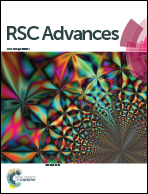Au–Ag bimetallic nanodendrite synthesized via simultaneous co-electrodeposition and its application as a SERS substrate
Abstract
We presented a novel Au–Ag bimetallic nanodendrite constructed through simple one-step co-electrodeposition on a Pt surface in the presence of iodide ions as a co-reagent. Simultaneously, we maneuvered to generate hydrogen bubbles from the same surface by the reduction of proton to drive the growth of deposition into the nanodendrite network structure. Au–Ag bimetallic nanodendrites composed of different atomic percentages of Au and Ag (0.00–5.12% Ag) were electrochemically synthesized by varying mole percentages of Au3+ and Ag+ in solutions. When atomic Ag concentration was from 0.39 to 3.84%, characteristic dendrite structure with high crystallinity was clearly observed; while, an imperfect nanodendrite structure became present when the atomic Ag concentration was over 3.84%. Further, the bimetallic nanodendrites with different Ag concentrations were used as a substrate for surface-enhanced Raman scattering (SERS) measurement. The SERS intensity of 2-naphthalenethiol was maximized when the nanodendrite containing 3.84% Ag was used. Incorporation of better plasmonic metal, Ag, into the nanodendrite structure was obviously advantages in enhancing SERS efficiency; while, maintaining a good bimetallic nanodendrite structure was a prerequisite for optimal SERS measurement.


 Please wait while we load your content...
Please wait while we load your content...